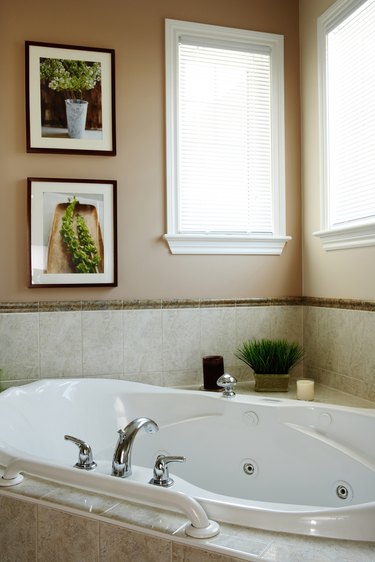Things You'll Need
Light construction adhesive
Expanding foam
Quick-setting concrete
Joint compound
Trowel
2-by-4
Building paper

A squeaky noise, especially in a fiberglass tub, means it is at risk of cracking. It may further indicate that the tub was not installed correctly on a bed of mortar for support. Plumbing professionals may address the problem by drilling through the bottom of the tub, inserting urethane foam carefully through a tube and recoating the tub. If you want to tackle the job yourself, a better avenue may be to get a look under the tub and work from the side and bottom of the tub.
Step 1
Access the area underneath the tub, via an existing access panel or by cutting one through the drywall of an adjacent bedroom or closet wall, or a hallway or stairway.
Video of the Day
Step 2
Check the situation under the tub with a work light. Look for the presence of a mortar bed and the condition of any plastic foam molded to the bottom of the tub. If the molded foam has come loose from the tub, reattach it with construction adhesive and shim the foam up firmly against the tub for the recommended drying time.
Step 3
Look for the mortar bed, which will resemble a concrete pad rather than a sheet of plywood, underneath the tub. If it isn't present and you encounter bare plywood, prepare to retrofit by spraying expanding foam around the drain hole to keep the mortar from dripping below the floor.
Step 4
Mix five gallons of quick-setting concrete or joint compound to act as mortar. Trowel the material on the plywood under the tub.
Step 5
Allow the mortar to self-level, ideally to a depth of 1/2 inch or enough to touch the bottom of the tub. Set up a 2-by-4 at the opening you are working through to contain the mortar bed. If you can get good access to the floor under the tub, staple building paper to the sub-floor before adding the mortar. Check your original tub instructions; Kohler drop-in baths, for example, recommend a deeper, two-inch mortar bed, requiring more concrete or joint compound.
Step 6
Leave the mortar to cure per the manufacturer's instructions, typically 24 to 48 hours. Remove the 2-by-4 and close up your access panel.
Tip
If the sub-floor isn’t plywood, place a pad between the bath and sub-floor to address squeaks, recommends Sterling Plumbing of Kohler, Wisconsin. The firm recommends spun bonded polyester landscape fabric or house wrap material. It advises against using roof felt.
Video of the Day